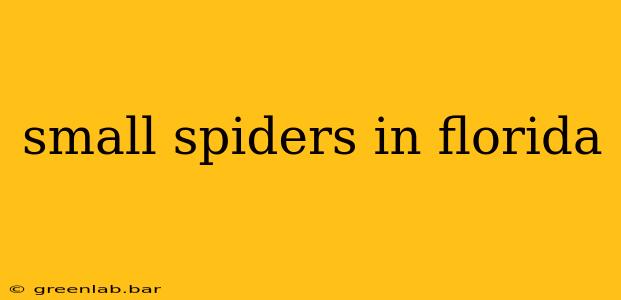Florida's warm, humid climate provides a perfect habitat for a diverse array of spiders, many of which are quite small. Identifying these tiny arachnids can be tricky, but understanding their common characteristics and potential habitats can help you better understand what you might encounter in your Florida home or garden. This guide will explore some of the most common small spiders found in the Sunshine State, focusing on their identification, behavior, and potential impact.
Common Types of Small Spiders in Florida
While hundreds of spider species inhabit Florida, several are frequently encountered and are generally small in size. These include:
1. Jumping Spiders (Family Salticidae):
- Size: Generally small, ranging from a few millimeters to about a centimeter in body length.
- Appearance: Known for their large, forward-facing eyes which give them excellent vision. They exhibit a wide range of colors and patterns, often mimicking their environment.
- Behavior: Active hunters, they stalk and pounce on their prey rather than building webs. They are often found on walls, fences, and vegetation.
- Potential Impact: Generally harmless to humans; their bite is rarely felt and poses no significant threat.
2. Cobweb Spiders (Family Theridiidae):
- Size: Small to medium-sized, with many species falling into the "small" category.
- Appearance: Often have rounded abdomens and relatively long legs. Colors can vary widely. The infamous black widow is a member of this family, but most Florida cobweb spiders are much smaller and less dangerous.
- Behavior: Construct irregular, sticky webs in sheltered areas such as corners, under eaves, and in cluttered spaces.
- Potential Impact: Most are harmless, but some may have mildly irritating bites.
3. Ground Spiders (Various Families):
Many small spiders reside in the soil and leaf litter. Precise identification at the species level often requires microscopic examination. These spiders are typically cryptic and rarely encountered unless actively searching in their habitat.
- Size: Highly variable, but many are quite small.
- Appearance: Appearance varies dramatically depending on the specific species.
- Behavior: Mostly nocturnal hunters, often residing in burrows or under rocks.
- Potential Impact: Generally harmless to humans.
4. Other Small Spiders:
Florida is home to numerous other small spider species belonging to various families. Precise identification requires specialized knowledge and often requires close examination under magnification.
Identifying Small Spiders: Challenges and Strategies
Identifying small spiders to the species level can be incredibly difficult, even for experts. Many species exhibit subtle differences in coloration and markings. However, observing the spider's habitat, web type (if present), and general body shape can provide clues. If you're concerned about a spider bite or need a definitive identification, contacting a local entomologist or pest control professional is advisable.
Are Small Spiders Harmful?
The vast majority of small spiders in Florida are harmless to humans. Their bites are rarely felt, and their venom is generally not medically significant. However, it's always wise to exercise caution and avoid handling spiders. If bitten, monitor the area for any adverse reactions and seek medical attention if necessary.
Preventing Small Spiders in Your Home
While eliminating all spiders from your home is virtually impossible, you can take steps to minimize their presence. This includes:
- Regular cleaning: Removing clutter, vacuuming regularly, and wiping down surfaces can eliminate potential hiding spots.
- Sealing entry points: Caulk cracks and crevices in walls and foundations to prevent spiders from entering.
- Landscaping: Keeping vegetation trimmed away from your home's exterior can reduce spider populations.
By understanding the diversity of small spiders inhabiting Florida and taking proactive measures, you can coexist peacefully with these fascinating creatures. Remember, most contribute to a healthy ecosystem by controlling insect populations.

